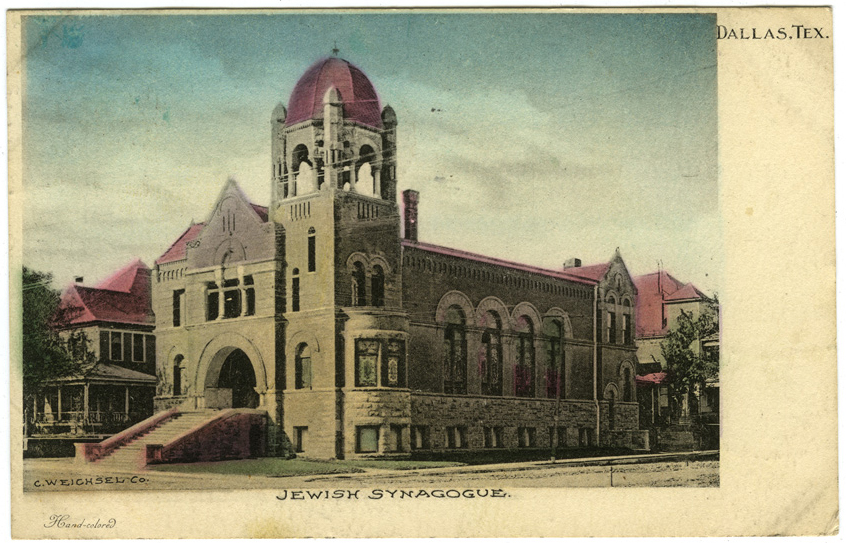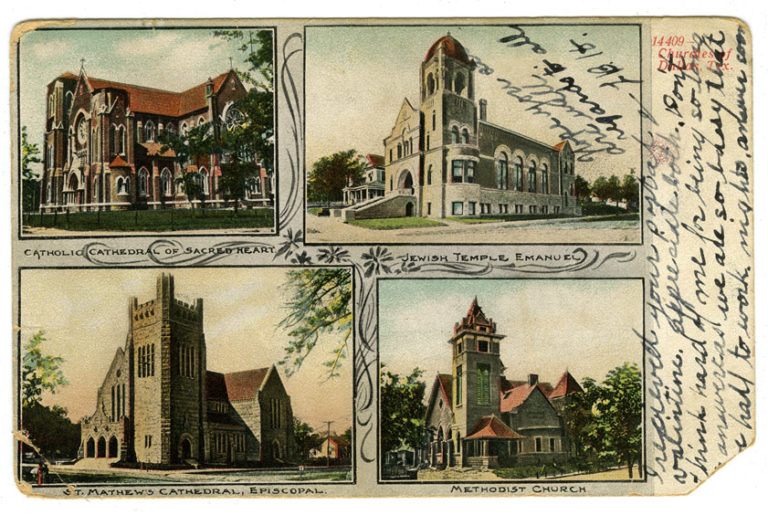3.8 Dallas, Texas
Congregation Emanu-El, South Ervay Street, corner of South Ervay and St. Louis streets
Architect unknown, 1899
C. Weichsel Company, publisher; no publication date, but postmarked June 24, 1908
This postcard depicts the second home of Congregation Emanu-El (God is with us), one of the leading Reform congregations in Texas. Dedicated in 1899, the building exhibits a robust design in the Richardsonian Romanesque style. The dominating corner building has heavy rusticated masonry, its tower topped with a baldachin-like lookout and surmounted by a high segmental dome. The monumental stairway leads from the sidewalk to the entrance under a broad arch that springs from low jambs. This treatment is typical of many of H. H. Richardson’s most famous buildings; it is also seen on synagogues such K.A.M. Isaiah Israel in Chicago, designed by Dankmar Adler and Louis Sullivan in 1890–91. In the South, this style for synagogues was not common, but a few other examples are depicted in this exhibition, such as Temple Israel in St. Louis (1888) and Baltimore Hebrew in Baltimore (1891).
Dallas’s Emanu-El was a bold design in the Texas city at the time, but nationally the style would soon fade, eclipsed by the rise of Roman-inspired classicism, which was popularized by the Chicago Columbian Exposition of 1893. Still, two large and impressive temples in St. Louis had recently been completed in a similar style, and perhaps these influenced the Dallas builders.
The entire ground floor—really the upper half of a basement level—was made of heavy stonework, creating a platform upon which the main floor sanctuary sat. Windows at ground level lit the basement, where classrooms and social rooms were located.
Emanu-El grew out of the first organized Jewish group in Dallas, the Hebrew Benevolent Association, founded in 1872 to help the sick, bury the dead, and hold religious services. Chartered in 1875 as the Jewish Congregation Emanu-El, the next year the new congregation built its first synagogue, a small red brick temple in the Byzantine style at Commerce and Church (now Field) streets.
Emanu-El occupied its second home on South Evray and St. Louis streets for less than two decades. In 1917, it moved to South Boulevard and Harwood Street, following the Jewish migration away from downtown. (The classical style of that sanctuary is also represented in this exhibition.) Then, in 1957, Emanu-El relocated again to Hillcrest Road.
The congregation was renamed Temple Emanu-El in 1974. Significantly, the postcard by the Weichsel Company, pictured here, labels the building simply as “Jewish synagogue.”

